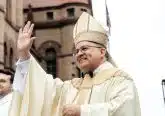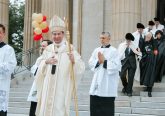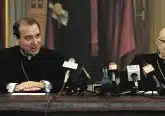Archbishop Schnurr Reflects on the Passing of Archbishop Emeritus Pilarczyk
Told by Apostolic Nuncio, Archbishop Pietro Sambi, in 2010 that he would become coadjutor to Archbishop Daniel E. Pilarczyk as Archbishop of Cincinnati, then-Bishop Dennis M. Schnurr was astonished and momentarily hesitant.
“I was surprised. It had been rumored that I was going to Omaha,” Archbishop Schnurr said.
Archbishop Sambi asked if there was a problem and Archbishop Schnurr said, “Those are big shoes to fill.”
“Yes,” said Archbishop Sambi. “I will pray for you.”
Later when the decision was announced, Archbishop Pilarczyk again surprised Archbishop Schnurr: “I got the man I wanted,” he said.
Although Archbishop Schnurr had known Archbishop Pilarczyk through their work with the National Conference of Catholic Bishops–U.S. Catholic Conference (now USCCB), he confesses, “Although I knew him, I was quite surprised. I didn’t think we knew one another that well.”
Archbishop Schnurr spoke at length of Archbishop Daniel E. Pilarczyk on the occasion of his passing with Anna Mitchell of Sacred Heart Radio.
The two first met in 1989 when then-Father Schnurr became Associate General Secretary of the National Conference of Catholic Bishops (NCCB) and Archbishop Pilarczyk was elected president of that organization. Archbishop Schnurr told Mitchell his first impressions of the man he would succeed was that he was brilliant, no-nonsense, had a quick wit and chose his words very carefully.
“He was a man who enjoyed life, and although part of that came through, he would never forget that he was a teacher,” Archbishop Schnurr said. “Some seminarians told me they thought he was stern, but I explained he never forgot to be the teacher, always in control, tolerating no nonsense and always ready to correct. However, he never meant to be harsh or unkind. He was just being who he was – the teacher.”
Archbishop Schnurr commented frequently in the interview on Archbishop Pilarczyk’s wit. “He was very quick and very dry, but he appreciated someone who would come back at him. He enjoyed that.”
Still, “He was regarded by his fellow bishops as an intellectual, a scholar. He was one of the few bishops who could carry on a conversation in Latin. It was like the old E.F. Hutton TV commercials: When he talked, people listened,” said Schnurr.
When Pope Benedict XVI, then Cardinal Joseph Ratzinger, called the bishops to Rome to discuss an issue, he first stated that he had a list of the five questions that had been submitted and asked if anyone had a question. “Archbishop Pilarczyk pointed at a hook in the middle of a vaulted ceiling in the meeting area,” Archbishop Schnurr said. “He asked, ‘Is that where you used to hang heretics?’” Archbishop Schnurr said, “I wanted to dive under a table, unsure of how Cardinal Ratzinger would react. But he laughed and he said, ‘Oh yes, I remember you…’ I expect they had many similar conversations.”
Archbishop Pilarczyk could also use his wit to get results. “When Pope John Paul II decided to hold the 1993 World Youth Day in the United States, he approached the Conference of U.S. bishops. Normally, a pope would decide in what diocese he wanted to hold the event and would tell that bishop to handle it.
“But Pope John Paul wanted to hold the event in the United States for two reasons: First, the pope said, the Americans are known for their administration and organization skills. And also, he wanted media attention and the United States is the center for world media.”
The pope said he would need someone to coordinate the event and Archbishop Pilarczyk, then-president of the NCCB, called Father Schnurr to his office. “He told me he wanted me to head up the event and I immediately said, ‘It’s not for me. I know almost nothing about youth ministry.’ He thought about it for a while and said, ‘You pray on it and I’ll pray on it and we’ll talk about it soon.’”
“The next day, we spoke again and he said, ‘Well, Father Schnurr, I have prayed on it and you’re going to do it.’”
Archbishop Schnurr said the youth event was a great success, but is modest about the accomplishment. “One of the people who was helping asked me after the first day if it all was going as I expected. I told him I didn’t recognize the event as planned. Surely the Holy Spirit became involved and guided us,” Archbishop Schnurr said, adding, “If he [Archbishop Pilarczyk] had not been insistent, I would not have done it.”
Archbishop Schnurr, who would rise to general secretary of the bishops’ conference, gives Archbishop Pilarczyk high marks for having the skills needed to be president of that organization. “He knew how to preside and conduct a meeting. He was an excellent parliamentarian. Simply superb. If one of the bishops spoke too long, he knew how to wind him down,” Archbishop Schnurr said.
Archbishop Pilarczyk, rector of Mount St. Mary’s Seminary & School of Theology, left his mark on the development of the seminary, Archbishop Schnurr said. And as archbishop, “he put together a very fine staff. He led the archdiocese for 27 years and when I arrived, the archdiocese was in good shape. He chose people who complemented his talents and filled in his weaknesses.”
Of the sex abuse crisis, Archbishop Schnurr said that Archbishop Pilarczyk’s no-contest plea is often seen as a guilty plea, “But that is incorrect. The Ohio bishops wanted a resolution. It was a difficult time for the Church. The agreement was that the Archbishop of Cincinnati would enter the plea and that a fund for victims would be established,” Archbishop Schnurr said. “I know he put his heart into it. It was a tragic moment.”
As bishop of Duluth, MN, Archbishop Schnurr received a phone call from Archbishop Sambi, the Apostolic Nuncio. He learned he would be headed for Cincinnati. “After seven years of everything landing on my desk, coming to Cincinnati was very liberating.”
Archbishop Pilarczyk wanted his coadjutor to take over the operation of what is now the pastoral ministries office. “That seemed wrong to me. We had a priest in charge who knew the office and he would come back to it in a year when I became the Archbishop of Cincinnati.”
“What will you do?” Archbishop Pilarczyk asked.
Archbishop Schnurr said that the archdiocese with more than 200 parishes, two dozen high schools and nearly 100 elementary schools, getting to know all of them was “easily a full-time job.” Archbishop Pilarczyk agreed.
“Archbishop Pilarczyk was very proud of the archdiocese,” Archbishop Schnurr said. “He gave me a three-volume history of the archdiocese and said, ‘The archdiocese is more than 150 years old, but people here will talk as though things happened just yesterday.’”
In 2011, he came to Archbishop Schnurr’s office and said, “Well, archbishop, if someone tells you they saw Pilarczyk in the gutter today, they were right. My legs just gave out.”
He was later diagnosed with Parkinson’s Disease, a long-term degenerative disorder of the central nervous system that mainly affects the motor system. As the disease worsens, non-motor symptoms become increasingly common.“Within a month, the disease affected his health, but he remained witty and jovial,” Archbishop Schnurr said. “More recently, his short-term memory was affected. He would imagine he had commitments and would be upset because he thought his driver was late.”
Archbishop Schnurr said the Little Sisters of the Poor at Archbishop Leibold Home took very good care of him and the archdiocesan chancellor, Father Steve Angi, visited twice a week to see to Archbishop Pilarczyk’s needs.
Archbishop Schnurr said Archbishop Pilarczyk “was very kind to me.” He recalled a visit at the Leibold home shortly before his death.“I was Archbishop of Cincinnati for 27 years. You’ve got better things to do than visit me,” Archbishop Pilarczyk said.
“He was a man who served the Church very, very well.”













